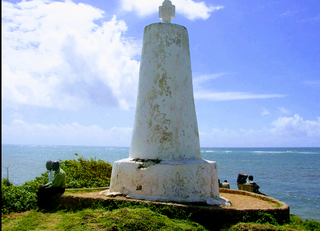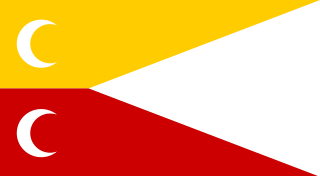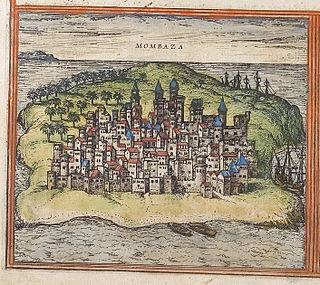Before 1502, the East African city of Mombasa was part of the Kilwa Sultanate. [1] The independent Mombasa sultanate named Mvita (Swahili) or Manbasa (Arabic) was then established but was conquered by the Portuguese Empire during the 16th century. After this control alternated between the Portuguese and the Sultanate of Oman,before the establishment of the British East Africa Protectorate in 1887. Mombasa became part of independent Kenya in 1963.
| Tenure | Incumbent | Notes |
|---|---|---|
| Portuguese Suzerainty | ||
| 1593 to 1596 | Mateus de Vasconcelos , Captain-Major | |
| 1596 to 1598 | António de Andrade , Captain-Major | |
| 1598 to 1606 | Rui Soares de Melo , Captain-Major | |
| 1606 to 1609 | Gaspar Pereira , Captain-Major | |
| 1609 to 1610 | Pedro de Abreu , Captain-Major | |
| 1610 to 1614 | Manuel Pereira, Captain-Major | |
| 1614 to 1620 | Simão Pereira, Captain-Major | |
| 1620 to 1625 | Francisco Pereira , Captain-Major | |
| 1625 to 1629 | Marçal de Macedo , Captain-Major | |
| 1629 to 15 August 1631 | Pedro de Gambôa , Captain-Major | |
| 15 August 1631 to 1635 | Pedro Botelho , Captain-Major | |
| 1635 to 1638 | Francisco de Seixas e Cabreira , Captain-Major | 1st Term |
| Portuguese Colony under Goa | ||
| 1638 to 1639 | Francisco de Seixas e Cabreira , Captain-Major | 1st Term |
| 1639 to 1642 | Martim Manuel , Captain-Major | |
| 1642 to 1643 | ...., Captain-Major | |
| 1643 to 1646 | Manuel Coutinho , Captain-Major | |
| 1646 to 1651 | António de Meneses , Captain-Major | |
| 1651 to 1653 | Francisco de Seixas e Cabreira , Captain-Major | 2nd Term |
| 1653 to 1658 | ..., Captain-Major | |
| 1658 to 1663 | José da Silva, Captain-Major | |
| 1663 to 1667 | Manuel de Campos , Captain-Major | |
| 1667 to 1670 | João Cota , Captain-Major | |
| 1670 to 1671 | vacant | |
| 1671 to 1673 | João da Costa , Captain-Major | |
| 1673 to 1676 | Manuel de Campos , Captain-Major | |
| 1676 to 1679 | Francisco Faria , Captain-Major | |
| 1679 to 16?? | Manuel Franco, Captain-Major | |
| 16?? to 1682 | Pedro Henriques, Captain-Major | |
| 1682 to 1686 | João Portugal , Captain-Major | |
| 1688 to 1693 | Duarte de Melo , Captain-Major | |
| 1693 to 1694 | Pascual Sarmento , Captain-Major | |
| 1694 to 1696 | João Leão, Captain-Major | |
| 1696 to 1697 | Antonio de Melo, Captain-Major | |
| 1697 to 1698 | Dau, príncipe de Faza , Captain-Major | |
| 1698 to 12 December 1698 | Leonardo Barbosa Souto-Maior , Captain-Major | |
| Omani Suzerainty | ||
| Wali (Swahili: Liwali ) (Governors) | ||
| 12 December 1698 to December 1698 | Imam Sa‘if ibn Sultan , Wali | |
| December 1698 to 12 March 1728 | Nasr ibn Abdallah al-Mazru‘i , Wali | |
| Portuguese Suzerainty | ||
| Portuguese Colony under Goa | ||
| 12 March 1728 to 21 September 1729 | Álvaro Caetano de Melo Castro , Captain-Major | |
| Omani Suzerainty | ||
| Wali (Swahili: Liwali ) (Governors) | ||
| 1729 to 1735 | ..., Wali | |
| 1735 to 1739 | Sa‘id al-Hadermi , Wali | |
| 1739 to 1745 | Muhammad ibn Uthman al-Mazru‘i , Wali | |
| 1746 | ‘Ali ibn Uthman al-Mazru‘i , Wali | |
| Independent (disputed with Oman) | ||
| 1746 to 1755 | Sultan ‘Ali ibn Uthman al-Mazru‘i | |
| 1755 to 1773 | Sultan Masud ibn Naisr al-Mazru‘i | |
| 1773 to 1782 | Sultan Abdallah ibn Muhammad al-Mazru‘i | |
| 1782 to 1811 | Sultan Ahmad ibn Muhammad al-Mazru‘i | |
| 1812 to 1823 | Sultan ‘Abd Allah ibn Ahmad al-Mazru‘i | |
| Omani Suzerainty | ||
| 1823 to 1826 | Sultan Sulayman ibn ‘Ali al-Mazru‘i | |
| 1826 to March 1835 | Salim ibn Ahmad al-Mazru‘i , Wali | |
| March 1835 to 1836 | Nasur ibn Ahmad al-Mazru‘i , Wali | |
| 1836 to 1837 | Rashid ibn Salim al-Mazru‘i | |
| 1837 to 24 June 1837 | Khamis ibn Rashid al-Mazru‘i | |
| 1837 to 1860 | Abdallah ibn Hamish al-Mazru‘i | |
| 1860 to 1873 | Mubarrak ibn Rashid al-Mazru‘i | |
| 1873 to 1 July 1895 | Rashid ibn Hamish al-Mazru‘i | |
| British Suzerainty | ||
| British Protectorate | ||
| 9 February 1824 to 13 February 1824 | William Fitzwilliam Owen , Governor | |
| 13 February 1824 to 29 May 1824 | John James Reitz , Governor | |
| 29 May 1824 to September 1824 | vacant | |
| September 1824 to 25 July 1826 | J.B. Emery , Governor | |
| Zanzibari Suzerainty | ||
| 24 June 1837 | Annexed by Zanzibar | |
| British Suzerainty | ||
| 25 May 1887 | Administration handed to the British East Africa Association | |
| 1 July 1895 | Kenya protectorate coastal strip nominally under Zanzibari sovereignty | |
| 12 December 1963 | Incorporated into independent Kenya | |















